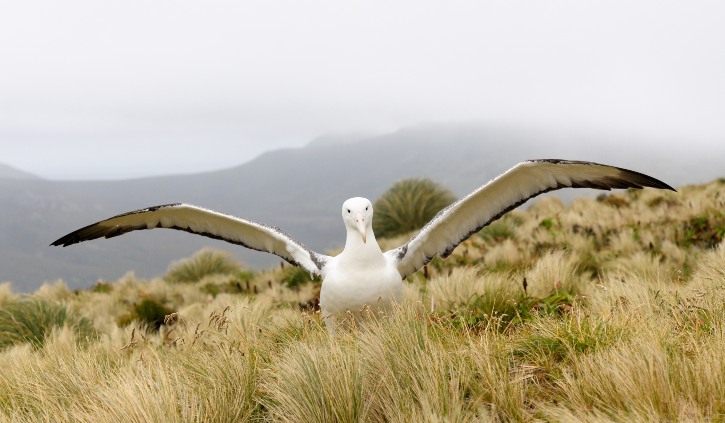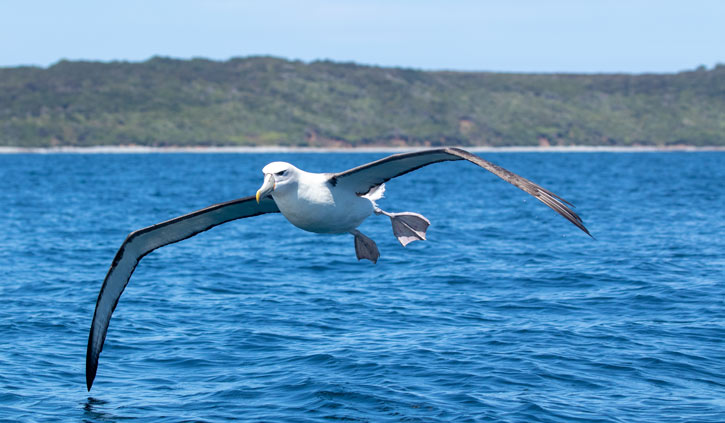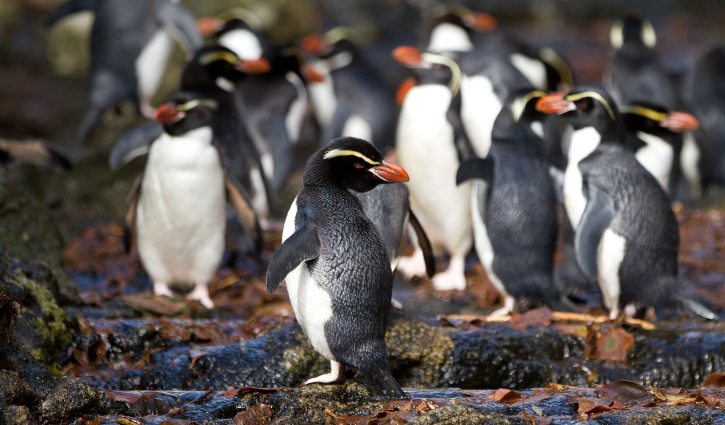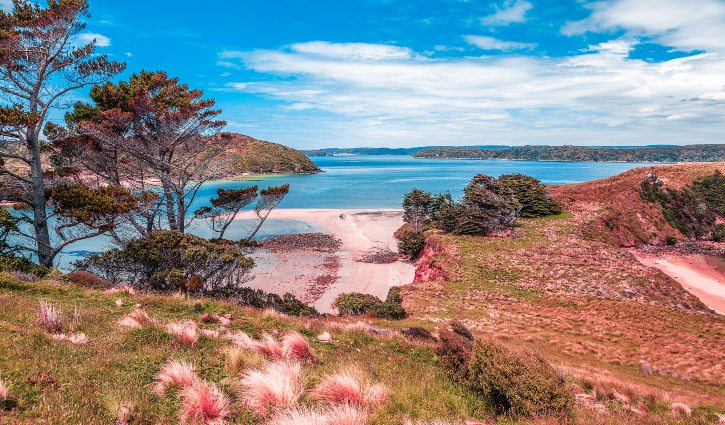
Beyond Fiordland12 Days
STYLE: LUXURY
Heritage Adventurer is an authentic small ship for expedition cruising offering an unforgettable exploration of New Zealand’s remote southern backyard on this special voyage. Discover the time-forgot rawness of wildlife rich Stewart and Ulva Islands before exploring the primordial majesty of Fiordland where clouds scud ragged peaks of glacier-cleaved mountains only accessible by expedition ship, and the rare opportunity to combine these iconic destinations on one voyage.
Cruising up the lower west side of New Zealand’s South Island, we prepare for the grand scale scenery of Fiordland. Exploring these remote ice-carved mountains, verdant forests and winding fiords, expect to encounter New Zealand Fur Seals, Dusky Dolphins, elusive birds and enjoy endless stunning vistas.
ITINERARY SUMMARY

DAY 1 QUEENSTOWN

Guests should make their way to the designated hotel where we will spend the first night of the expedition. This evening there will be an informal get-together at the hotel for dinner; an excellent opportunity to meet fellow adventurers on your voyage and some of our expedition team.
DAY 2 PORT BLUFF

Today we enjoy breakfast in the hotel restaurant and have the morning free to explore Queenstown before returning to the hotel for lunch and departing for the Port of Bluff to embark your ship. There’s time to settle into your cabin and explore the ship. Join the expedition team in the Observation Lounge and up on the Observation Deck setting course to Campbell Island. Sail past Ruapuke Island and Stewart Island. Despite appearing quite small on most maps it is really quite large and has a 700 kilometre coastline. Seabirds that we may encounter at this early point in the voyage include: albatross, petrels, cormorants, gulls and Little Blue Penguins.
DAY 3 AT SEA

As we make our way through the Southern Ocean we take the opportunity to learn more about the flora and fauna as we prepare for our arrival at Campbell Island. Great birding opportunities which may include the Wandering Albatross, Royal Albatross, Black-browed Albatross, Light-mantled Sooty Albatross, Salvin’s Albatross, Campbell Island Albatross, Northern and Southern Giant Petrel, Sooty Shearwater and Little Shearwater. There should be plenty of petrels and again the hard to identify prion species. Expect some of the best pelagic birding on this leg of the journey from Bluff to Campbell Island with great views during the crossing.
DAY 4 CAMPBELL ISLAND

A full day exploring Campbell Island and its history is rich and varied. Discovered in 1810, it was soon occupied by sealers who introduced rats and cats. Farming followed from 1895 to 1934 when it was abandoned. Coastwatchers were stationed on the island during the war and at the end of the war the station was taken over by the New Zealand Metrological service. They maintained a manned weather/ research station there until 1995. The island is now declared predator free, the way was clear to reintroduce the endangered Campbell Island Flightless Teal, which had been rediscovered on an offshore island in 1975. Snipe, which were formerly unknown from the island but were discovered on another offshore island, recolonised the islands themselves. The vegetation which the great English botanist Sir Joseph Hooker described in 1841 as having a “Flora display second to none outside the tropics” is flourishing and is nothing short of spectacular. We will offer a number of options which will enable you to explore the island including an extended walk to Northwest Bay. There will also be an easier walk to the Col Lyall Saddle. All of these options will allow you the opportunity and time to enjoy the Southern Royal Albatross which nest here in large numbers. We also visit areas of the island which contain outstanding examples of the megaherbs for which the island is renowned.
DAY 5 AUCKLAND ISLANDS – CARNLEY HARBOUR

In the south of the archipelago there is a very large sheltered harbour rich in human history including shipwrecks, treasure hunters, Coastwatchers and, of course, scientific parties. We plan to arrive mid-morning entering the harbour through the eastern entrance which is guarded on both sides by dramatic cliffs and climb there will be an opportunity to Zodiac cruise along the coast of Adams Island, Western Harbour and Victoria Passage. Other options include the Tagua Bay Coastwatcher’s hut and lookout which was occupied during the Second World War. We could visit Epigwatt and the remains of the ‘Grafton’ which was wrecked here in 1864. All five men aboard survived and lived here for 18 months before sailing their modified dinghy to New Zealand to get help. Two of the survivors wrote books about their ordeal, their first-hand accounts tell us a lot about their time here. Later this evening we will sail up the eastern coast, making our way to Port Ross in preparation for our landing at Enderby Island.
DAY 6 AUCKLAND ISLANDS – ENDERBY ISLAND

Enderby Island is one of the most beautiful islands in this group and is named after the same distinguished shipping family as one of our own vessels. This northern most island in the archipelago is an outstanding wildlife and birding location and is relatively easy to land on and walk around. Cleared of all introduced animals (pests) in 1994 and both birds and the vegetation, especially the herbaceous plants, are recovering both in numbers and diversity. Our plan is to land at Sandy Bay, one of three breeding areas in the Auckland Islands for the Hooker’s or New Zealand Sea Lion, a rare member of the seal family. Beachmaster bulls gather on the beach, defending their harems from younger (ambitious) males, to mate with the cows shortly after they have given birth to a single pup. During our day ashore there will be several options, some longer walks, some shorter walks and time to spend just sitting and enjoying the wildlife. The walking is relatively easy. A boardwalk traverses the island to the dramatic western cliffs, from there we follow the coast and circumnavigate the island. Birds that we are likely to encounter include the following species: Southern Royal Albatross, Northern Giant Petrel, Auckland Island Shag, Auckland Island Flightless Teal, Auckland Island Banded Dotterel, Auckland Island Tomtit, Bellbird, Pipit, Red-crowned Parakeet, Yellow-eyed Penguin and Light-mantled Sooty Albatross and a chance of seeing the Subantarctic Snipe. Look out for the Goldfinch, Song Thrush, Blackbird, European Starling, Red-billed Gull and Redpoll. On Derry Castle Reef we will look for migratory waders which could include Bar-tailed Godwit, Turnstone and possibly vagrants.
DAY 7 THE SNARES – NORTH EAST ISLAND

The closest Subantarctic Islands to New Zealand, they were appropriately called The Snares as they were once considered a hazard for sailing ships. Uninhabited and enjoy the highest protection as Nature Reserves. It is claimed by some that these islands are home to more nesting seabirds than all of the British Isles together. We will Zodiac cruise along the sheltered eastern side of the main island if the weather and sea conditions are suitable. In the sheltered bays, we should see the endemic Snares Crested Penguin, Snares Island Tomtit and Fernbirds. There are hundreds of thousands of Sooty Shearwaters nesting on The Snares; the actual number is much debated. Buller’s Albatross breed here from early January onwards. There will be opportunities to view the forests of large tree daisy Olearia lyallii which forms a canopy over much of the island group.
DAY 8 STEWART ISLAND/INVERCARGILL/QUEENSTOWN

Spend the morning exploring Stewart and Ulva Islands. Rich in history and wildlife, Ulva Island has been predator -free since 1997 and its bird song and wildlife is some of the best in New Zealand. Say your farewells and transfer to either Invercargill or Queenstown Airport.
DAYS 9 – 11 FIORDLAND

Plenty of time to explore the incredible wilderness of fiords in the south-west corner of the South Island. Fiordland was well known to local Maori people, with the demi-god Tu-teraki-whanoa being said to have used his adze, Te Hamo, to carve out the region’s fiords. Captain Cook and his crew landed here on HMS Resolution in 1773. Fiordland’s coast is only accessible by sea, making it the most remote region of New Zealand’s mainland. Waterfalls, streams, rivers and fiords are enveloped with misty veils that come and go, revealing steep gradients of mountain peaks and sheltered valleys. Bottlenose Dolphins, Fiordland Crested Penguins and Little Penguins are all residents of the fiords; during our time here we will look out for them. Areas we plan to visit during our time in Fiordland include Doubtful Sound, Dusky Sound and Acheron Passage, Astronomer’s Point and Pickersgill Harbour.
DAY 12 INVERCARGILL/QUEENSTOWN

Arriving in the Port of Bluff and after a final breakfast farewell your fellow voyagers and take a complimentary coach transfer to either Invercargill or Queenstown Airports.


